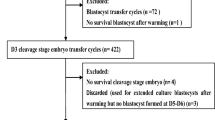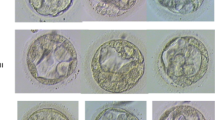Abstract
Purpose
To evaluate the effect of the size of zona pellucida opening by laser assisted hatching for frozen cleaved embryo that were thawed after both fresh and frozen cleaved embryo transfer cycles failed and were cultured to blastocyst after thawing in patients with multiple implantation failures.
Materials and methods
Of 101 consecutive procedures (October 2003 to June 2006), 30 patients declined to perform assisted hatching and were selected as control group, 40 patients had 40 μm opening of the zona (October 2003 to January 2005), 31 patients had 50% of the zona opening (February 2005 to June 2006).
Results
The pregnancy, implantation and delivery rates were significantly higher in 50% opening group (74%, 52% and 65%) compared to control group (17%, 10% and 13%; P < 0.01) and 40 μm opening group (43%, 27% and 38%; P < 0.04).
Conclusions
The size of the zona pellucida opening may affect the outcome of frozen cleaved embryo transfer.



Similar content being viewed by others
References
European IVF-Monitoring Programme (EIM) for the European Society of Human Reproduction and Embryology (ESHRE). Assisted reproductive technology in Europe, 2000. Results generated from European registers by ESHRE. Hum Reprod. 2004;19:490–503.
Primi MP, Senn A, Montag M, Van der Ven H, Mandelbaum J, Veiga A, et al. A European multicentre prospective randomized study to assess the use of assisted hatching with a diode laser and the benefit of an immunosuppressive/antibiotic treatment in different patient populations. Hum Reprod. 2004;19:2325–33.
Ng EH, Naveed F, Lau EY, Yeung WS, Chan CC, Tang OS, et al. A randomized double-blind controlled study of the efficacy of laser-assisted hatching on implantation and pregnancy rates of frozen-thawed embryo transfer at the cleavage stage. Hum Reprod. 2005;20:979–85.
Sifer C, Sellami A, Poncelet C, Kulski P, Martin-Pont B, Bottero J, et al. A prospective randomized study to assess the benefit of partial zona pellucida digestion before frozen-thawed embryo transfers. Hum Reprod. 2006;21:2384–9.
Gabrielsen A, Agerholm I, Toft B, Hald F, Petersen K, Aagaard J, et al. Assisted hatching improves implantation rates on cryopreserved-thawed embryos. A randomized prospective study. Hum Reprod. 2004;19:2258–62.
Balaban B, Urman B, Yakin K, Isiklar A. Laser-assisted hatching increases pregnancy and implantation rates in cryopreserved embryos that were allowed to cleave in vitro after thawing: a prospective randomized study. Hum Reprod. 2006;21:2136–40.
De Vos A, Van Steirteghem A. Zona hardening, zona drilling and assisted hatching: new achievements in assisted reproduction. Cells Tissues Organs. 2000;166:220–7.
Cohen J, Elsner C, Kort H, Massey J, Mayer MP, Wiemer K. Impairment of the hatching process following IVF in the human and improvement of implantation by assisted hatching using micromanipulation. Hum Reprod. 1990;5:7–13.
Cohen J, Alikani M, Trowbridge J, Rosenwaks Z. Implantation enhancement by selective assisted hatching using zona drilling of human embryos with poor prognosis. Hum Reprod. 1992;7:685–91.
Germond M, Rink K, Nocera D, Delacretaz G, Senn A, Fakan S. Microdissection of mouse and human zona pellucida using a 1.48-mm diode laser beam: efficacy and safety of the procedure. Fertil Steril. 1995;64:604–11.
Mantoudis E, Podsiadly BT, Gorgy A, Venkat G, Craft IL. A comparison between quarter, partial and total laser assisted hatching in selected infertility patients. Hum Reprod. 2001;16:2182–6.
Blake DA, Forsberg AS, Johansson BR, Wikland M. Laser zona pellucida thinning—an alternative approach to assisted hatching. Hum Reprod. 2001;16:1959–64.
Hsieh YY, Huang CC, Cheng TC, Chang CC, Tsai HD, Lee MS. Laser-assisted hatching of embryos is better than the chemical method for enhancing the pregnancy rate in women with advanced age. Fertil Steril. 2002;78:179–82.
Gardner DK, Schoolcraft WB. In-vitro culture of human blastocysts. In: Jansen R, Mortimer D, editors. Towards reproductive certainty: fertility and genetics beyond 1999. London, UK: Parthenon; 1999. p. 378–88.
Fong CY, Bongso A, Ng SC, Kumar J, Trounson A, Ratnam S. Blastocyst transfer after enzymatic treatment of the zona pellucida: improving in-vitro fertilization and understanding implantation. Hum Reprod. 1998;13:2926–32.
Tucker MJ, Cohen J, Massey JB, Mayer MP, Wiker SR, Wright G. Partial dissection of the zona pellucida of frozen-thawed human embryos may enhance blastocyst hatching, implantation, and pregnancy rates. Am J Obstet Gynecol. 1991;165:341–5.
Check JH, Hoover L, Nazari A, O’Shaughnessy A, Summers D. The effect of assisted hatching on pregnancy rates after frozen embryo transfer. Fertil Steril. 1996;65:254–7.
DeFelici M, Siracusa G. Spontaneous hardening of the zona pellucida of mouse oocytes during in vitro culture. Gamete Res. 1982;6:107–13.
Downs SM, Schroeder AC, Eppig JJ. Serum maintains the fertilizability of mouse oocytes matured in vitro by preventing hardening of the zona pellucida. Gamete Res. 1986;15:115–22.
Lyu QF, Wu LQ, Li YP, Pan Q, Liu DE, Xia K, et al. An improved mechanical technique for assisted hatching. Hum Reprod. 2005;20:1619–23.
Kasai M. Advances in the cryopreservation of mammalian oocytes and embryos: development of ultrarapid vitrification. Reprod Med Biol. 2002;1:1–9.
Hartshorn C, Anshelevich A, Wangh LJ. Rapid, single-tube method for quantitative preparation and analysis of RNA and DNA in samples as small as one cell. BMC Biotechnol. 2005;13(5):2.
Hartshorn C, Anshelevich A, Wangh LJ. Laser zona drilling does not induce hsp70i transcription in blastomeres of eight-cell mouse embryos. Fertil Steril. 2005;84:1547–50.
Kanyo K, Konc J. A follow-up study of children born after diode laser assisted hatching. Eur J Obstet Gynecol Reprod Biol. 2003;110:176–80.
Gardner DK, Surrey E, Minjarez D, Leitz A, Stevens J, Schoolcraft WB. Single blastocyst transfer: a prospective randomized trial. Fertil Steril. 2004;81:551–5.
Author information
Authors and Affiliations
Corresponding author
Additional information
Capsule
The size of the zona pellucida opening by laser assisted hatching may affect the outcome of frozen cleaved embryo transfer in multiple implantation failures.
Rights and permissions
About this article
Cite this article
Hiraoka, K., Fuchiwaki, M., Hiraoka, K. et al. Effect of the size of zona pellucida opening by laser assisted hatching on clinical outcome of frozen cleaved embryos that were cultured to blastocyst after thawing in women with multiple implantation failures of embryo transfer: a retrospective study. J Assist Reprod Genet 25, 129–135 (2008). https://doi.org/10.1007/s10815-008-9214-5
Received:
Accepted:
Published:
Issue Date:
DOI: https://doi.org/10.1007/s10815-008-9214-5




